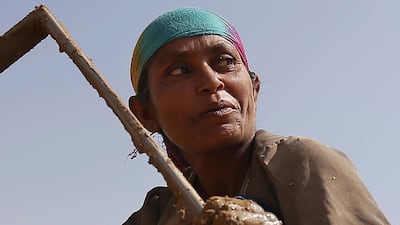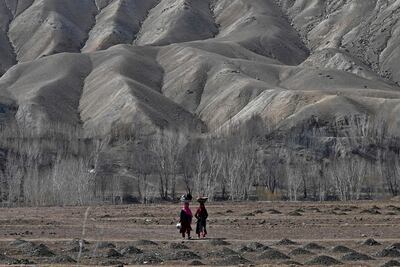International Women's Day, which has been marked for the past 110 years, is an occasion to celebrate the progress that has been made around the world towards narrowing the gender gap, particularly here in the UAE. But as the dust thrown up by the pandemic starts to settle, a new world is taking shape, formed by the huge upheaval of Covid-19. We must also reflect on how the tumult of the past year affected women around the globe.
Women appear to have been disproportionately affected by the virus. Last week, The National reported on PwC's Women in Work Index and the company's fears of an emerging "she-cession" in the UK jobs market. The firm predicted that levels of gender parity in the OECD – an organisation representing 37 leading free-market economies – which have otherwise been increasing year on year, will fall back to 2017 levels in 2021.
Addressing gender imbalances is not forgetting the many men also left behind by the virus
Pandemics have always been particularly damaging to women's interests. Last April, the UN Secretary General, Antonio Guterres, called for an end to the horrifying rise in domestic violence against women during lockdowns. In the Middle East, the research network Arab Barometer recorded huge rises in perceived violence against women, as high as 63 per cent in Tunisia and 27 per cent in Jordan.
Surveys in the US and UK have also suggested that care burdens at home have been primarily borne by women, leading to a disproportionately high number of female carers reducing their work hours, or leaving jobs altogether, compared to men.
Editorials from The National
Societies cannot tolerate a scenario in which women, already chasing parity with men in the workplace before the pandemic, start carrying yet heavier burdens after Covid-19. If this moral argument fails to convince all fully, there are also huge financial incentives to addressing this historic imbalance. PwC's report estimates a $6 trillion boost to the GDP of the OECD if future levels of female employment match ones currently found in Sweden, a consistent leader in the field.
One country that is building foundations towards this end is the UAE. Whether guaranteeing equal pay for men and women in 2018, or introducing three months' paid maternity leave for government employees the following year, the government has taken the lead in trying to create a fair system, wherein both men and women can succeed. The results are for all to see: in 2019, it was reported that 53 per cent of the UAE's total workforce consisted of women and today 66 per cent of government jobs are held by them.
Acknowledging emerging divisions in today's new reality is imperative. More optimistic, and not measured by statistics, has been the major collaboration between men and women that allowed us all to pull through the worst of the past year. Addressing specifically gender imbalances is not, as some believe, forgetting the many men also left behind by the virus. It is instead an endeavour that will strengthen us all, men and women, as we emerge dazed but determined into recovery.
Lexus LX700h specs
Engine: 3.4-litre twin-turbo V6 plus supplementary electric motor
Power: 464hp at 5,200rpm
Torque: 790Nm from 2,000-3,600rpm
Transmission: 10-speed auto
Fuel consumption: 11.7L/100km
On sale: Now
Price: From Dh590,000
More on Quran memorisation:
The White Lotus: Season three
Creator: Mike White
Starring: Walton Goggins, Jason Isaacs, Natasha Rothwell
Rating: 4.5/5
The specs
Engine: 2.0-litre turbo 4-cyl
Transmission: eight-speed auto
Power: 190bhp
Torque: 300Nm
Price: Dh169,900
On sale: now
MORE ON IRAN'S PROXY WARS
Rafael Nadal's record at the MWTC
2009 Finalist
2010 Champion
Jan 2011 Champion
Dec 2011 Semi-finalist
Dec 2012 Did not play
Dec 2013 Semi-finalist
2015 Semi-finalist
Jan 2016 Champion
Dec 2016 Champion
2017 Did not play
Auron Mein Kahan Dum Tha
Starring: Ajay Devgn, Tabu, Shantanu Maheshwari, Jimmy Shergill, Saiee Manjrekar
Director: Neeraj Pandey
Rating: 2.5/5
Election pledges on migration
CDU: "Now is the time to control the German borders and enforce strict border rejections"
SPD: "Border closures and blanket rejections at internal borders contradict the spirit of a common area of freedom"
AIR
%3Cp%3E%3Cstrong%3EDirector%3A%20%3C%2Fstrong%3EBen%20Affleck%3Cbr%3E%3Cbr%3E%3Cstrong%3EStars%3A%20%3C%2Fstrong%3EMatt%20Damon%2C%20Jason%20Bateman%2C%20Ben%20Affleck%2C%20Viola%20Davis%3Cbr%3E%3Cbr%3E%3Cstrong%3ERating%3A%3C%2Fstrong%3E%204%2F5%3C%2Fp%3E%0A
Types of policy
Term life insurance: this is the cheapest and most-popular form of life cover. You pay a regular monthly premium for a pre-agreed period, typically anything between five and 25 years, or possibly longer. If you die within that time, the policy will pay a cash lump sum, which is typically tax-free even outside the UAE. If you die after the policy ends, you do not get anything in return. There is no cash-in value at any time. Once you stop paying premiums, cover stops.
Whole-of-life insurance: as its name suggests, this type of life cover is designed to run for the rest of your life. You pay regular monthly premiums and in return, get a guaranteed cash lump sum whenever you die. As a result, premiums are typically much higher than one term life insurance, although they do not usually increase with age. In some cases, you have to keep up premiums for as long as you live, although there may be a cut-off period, say, at age 80 but it can go as high as 95. There are penalties if you don’t last the course and you may get a lot less than you paid in.
Critical illness cover: this pays a cash lump sum if you suffer from a serious illness such as cancer, heart disease or stroke. Some policies cover as many as 50 different illnesses, although cancer triggers by far the most claims. The payout is designed to cover major financial responsibilities such as a mortgage or children’s education fees if you fall ill and are unable to work. It is cost effective to combine it with life insurance, with the policy paying out once if you either die or suffer a serious illness.
Income protection: this pays a replacement income if you fall ill and are unable to continue working. On the best policies, this will continue either until you recover, or reach retirement age. Unlike critical illness cover, policies will typically pay out for stress and musculoskeletal problems such as back trouble.




